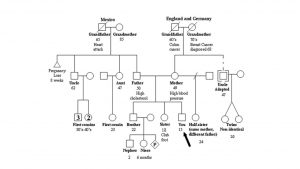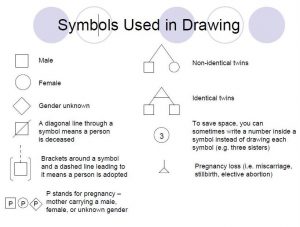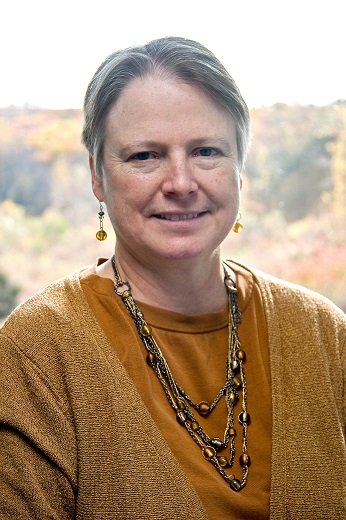 Figure One: Sample genogram, courtesy of National Society of Genetic Counselors, http://nsgc.org/p/cm/ld/fid=143, accessed 30 May 2016.
Figure One: Sample genogram, courtesy of National Society of Genetic Counselors, http://nsgc.org/p/cm/ld/fid=143, accessed 30 May 2016.
Twenty-first century genealogists enthusiastically debate the relative merits of different types of DNA testing: autosomal (atDNA), Y chromosome (Y-DNA) and mitochondrial DNA (mtDNA). But how often do you hear discussions about a medical family history or medical pedigrees? And yet knowing one’s medical family history may the best predictor of your risk or a relative’s risk of developing specific but also preventable or treatable diseases.
The predisposition to many illnesses may rest in our genes. Examples include cancer (up to 33% of diagnoses associated with our genetic heritage[1]), functional alcoholism (60% genetic[2]), and asthma (50% genetic[3]). So paying attention to our ancestors’ medical history makes sense.
A medical genogram is a simple and effective way to capture and display your medical pedigree (see Figure 1). Begin by making a list of all your family members, going back to at least your grandparents, if not farther. Then interview as many relatives as possible. (Sound familiar? All good genealogists interview their families!) Next to each person’s name document their age or date of birth, date of death, and key medical conditions. Your list of conditions may include: cancer, heart disease, diabetes, asthma, mental illness, high blood pressure, stroke, kidney disease, birth defects (e.g. spina bifida, cleft lip, heart defect), developmental delays or disorders (e.g. issues with cognitive functioning, autism spectrum), vision or hearing loss at an early age, or known genetic conditions, such as cystic fibrosis or sickle cell. The date of onset of each condition should be included, when known.
 Figure Two: Standard medical genogram symbols, courtesy of National Human Genome Research Institute, “Your Family Health History,” url: https://www.genome.gov/pages/education/modules/yourfamilyhealthhistory.pdf, accessed 30 May 2016.
Figure Two: Standard medical genogram symbols, courtesy of National Human Genome Research Institute, “Your Family Health History,” url: https://www.genome.gov/pages/education/modules/yourfamilyhealthhistory.pdf, accessed 30 May 2016.
Now you are ready to draw (see Figure 2). On a medical genogram males are displayed by a square and women by a circle. Begin by placing yourself towards the bottom of the chart and call attention to yourself with an arrow. Add your siblings and their key medical conditions – older siblings to the left and younger siblings to the right, with vertical lines upward from the gender symbol. Join your siblings by a horizontal line. Next add your parents, grandparents, and great-grandparents. Detailed instructions for the drawing process may be found at the National Human Genome Research Institute.[4]
As genealogists we have a responsibility to preserve the past. We can also safeguard the future by using our skills to accurately and reliably collect, and ethically share, information about our medical heritage. Keep in mind that medical information is private and the medical genogram you create should be treated with the same degree of respect as your own medical record. This is not meant to deter you from the quest for information, but to caution you about its sharing. After all, with your newfound knowledge the life you save may be your own!
Notes
[1] L. A. Mucci et al., “Familial Risk and Heritability of Cancer Among Twins in Nordic Countries,” Journal of the American Medical Association 315 [2016]: 68-76. Abstract accessed at http://jama.jamanetwork.com/article.aspx?articleid=2480486 on 30 May 2016.
[2] Sanjay Gupta, “Are you a Functional Alcoholic,” Everyday Health, accessed at http://www.everydayhealth.com/sanjay-gupta/are-you-a-functional-alcoholic/ on 30 May 2016.
[3] World Health Organization, “Genetics and Asthma,” http://www.who.int/genomics/about/Asthma.pdf, accessed 30 May 2016.
[4] National Human Genome Research Institute, “Your Family Health History,” url: https://www.genome.gov/pages/education/modules/yourfamilyhealthhistory.pdf, accessed 30 May 2016.
Share this:

About Ann Lawthers
Ann G. Lawthers assists our library patrons in enhancing their research skills and in bringing alive their family histories. She is a graduate of Wellesley College, the Harvard School of Public Health and has completed the Boston University Certificate in Genealogical Research program. She has conducted genealogical projects as an independent researcher. Ann is familiar with resources for Massachusetts, Vermont, Pennsylvania, Maryland, New Jersey; and has research experience with Quebec and the Canadian Atlantic Provinces, Ireland and Germany.View all posts by Ann Lawthers →